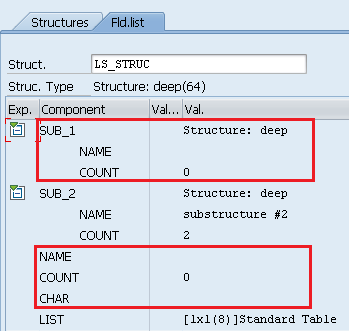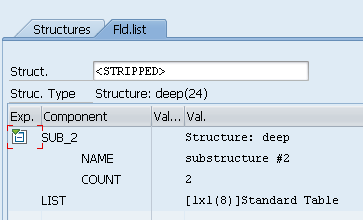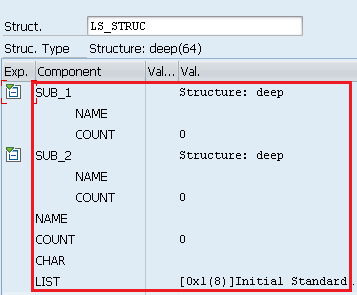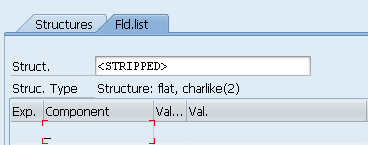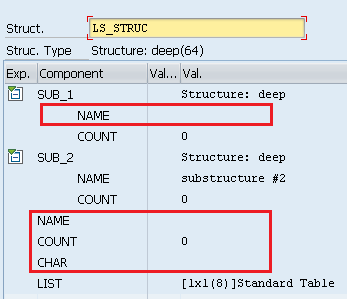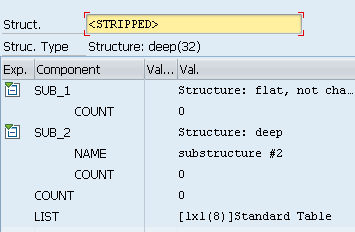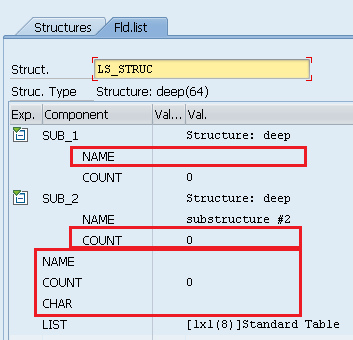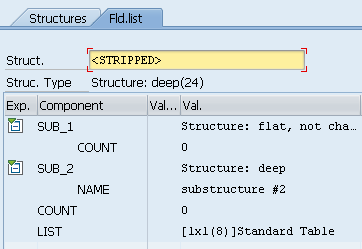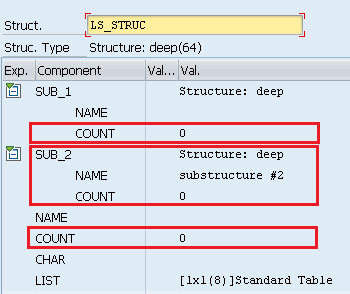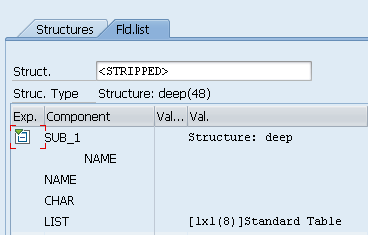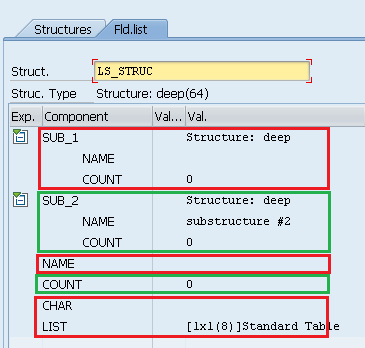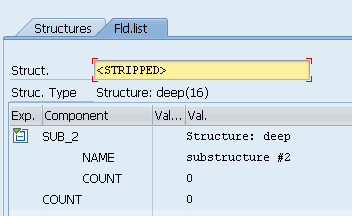Abap strip is a method to remove structure elements at runtime (creating a new structure via runtime). This is useful, when a webservice returns a potentially large structure, where each response uses only a fraction of the whole structure.
Inhaltsverzeichnis
- 1 This is an old version of this page. To the new page please click here
- 2 Das ist eine alte Version dieser Seite. Zur neuen Seite klicken sie hier
- 3 class /EPO1/CL_TOOLS, method ABAP_STRIP
- 4 examples - how to use
- 4.1 structure, data
- 4.2 accessing the stripped structure
- 4.3 using IV_STRIP_INITIAL
- 4.4 using IV_STRIP_INITIAL on an initial structure
- 4.5 using IT_KEEP with IV_STRIP_INITIAL
- 4.6 using IT_KEEP with IV_STRIP_INITIAL and IV_RECURSIVE
- 4.7 using IT_STRIP
- 4.8 using IV_STRIP_EVERYTHING together with IT_KEEP
- 5 complete report sourcecode
- 6 creating JSON strings
- 7 Example: Stripping JSON Request for Outbound web service
This is an old version of this page. To the new page please click here
Das ist eine alte Version dieser Seite. Zur neuen Seite klicken sie hier
class /EPO1/CL_TOOLS, method ABAP_STRIP
This is a static method, and therefore can be called without creating an object of the class:
/epo1/cl_tools=>abap_strip(.. ).
Parameters
Meaning of the ABAP-STRIP - parameters:
- IS_ANY: a structure to be stripped
- IT_KEEP: list of elements, which should be kept (this list has the highest priority);
format of the element names is like in ABAP: ELEMENT-SUB_ELEMENT-SUB_SUB_ELEMENT-.. - IT_STRIP: list of elements, which should be stripped (except, when listed in IT_KEEP)
example to strip the CALLSTATUS structure from the result of an GFMC function module: append 'CALLSTATUS' to IT_STRIP
example to strip the element EV_RESULT from the export - structure of an GFMC function module: append 'EXPORT-EV_RESULT' to IT_STRIP - IV_STRIP_INITIAL: if 'X', remove all empty elements (structures, tables, primitive elements)
- IV_RECURSIVE: if 'X', recurse IV_STRIP_INITIAL to all substructures
- IV_STRIP_EVERYTHING: if 'X', strip all elements - except when listed in IT_KEEP
- EV_CHANGED: 'X', if the structure has been changed (else: ' ')
- ER_ANY: reference to the new structure, filled with the values of the original structure
Note: elements and sub-elements are to be written as in ABAP (e.g. ELEMENT-SUB_ELEMENT-SUB_SUB_ELEMENT-...)
examples - how to use
structure, data
The following structure will be used for all examples below:
TYPES:
BEGIN OF lty_sub_struc,
name TYPE string,
count TYPE i,
END OF lty_sub_struc,
BEGIN OF lty_struc,
sub_1 TYPE lty_sub_struc,
sub_2 TYPE lty_sub_struc,
name TYPE string,
count TYPE i,
char TYPE char10,
list TYPE STANDARD TABLE OF string WITH NON-UNIQUE KEY table_line,
END OF lty_struc.
The following data definition will be used for the examples below:
FIELD-SYMBOLS:
<stripped> TYPE any.
DATA:
ls_struc TYPE lty_struc,
lr_stripped TYPE REF TO data,
lt_keep TYPE /epo1/ec_string_table,
lt_strip TYPE /epo1/ec_string_table.
accessing the stripped structure
Assign the referenced data to a field symbol:
ASSIGN lr_stripped->* TO <stripped>.
Afterwards, the field symbol may be used like any other structure (e.g. to create a JSON string).
using IV_STRIP_INITIAL
Fill the structure only partially, every empty element (of the main structure) should be removed. This might be the most wanted use case:
" fill the data
ls_struc-sub_2-name = 'substructure #2'.
ls_struc-sub_2-count = 2.
APPEND 'teststring' TO ls_struc-list.
Data of the structure:
So we would remove the whole SUB_1 structure (but not SUB_2) and the elements NAME, COUNT and CHAR (but not LIST).
Method call:
/epo1/cl_tools=>abap_strip(
EXPORTING
IS_ANY = ls_struc
IV_STRIP_INITIAL = 'X'
IMPORTING
ER_ANY = lr_stripped ).
ASSIGN lr_stripped->* TO <stripped>.
And the result (assigned to the field symbol '<STRIPPED>')
using IV_STRIP_INITIAL on an initial structure
SHOULD NEVER HAPPEN..
When creating a structure with the runtime, there must be at least one element. Whenever a structure is to be created, where there is no element left, we create a dummy element with the name '_'. This may also occur in sub-structures which must be kept, but all elements are to be stripped.
Data of the (empty) structure:
Method call:
/epo1/cl_tools=>abap_strip(
EXPORTING
IS_ANY = ls_struc
IV_STRIP_INITIAL = 'X'
IMPORTING
ER_ANY = lr_stripped ).
ASSIGN lr_stripped->* TO <stripped>.
So we would have to remove all of the structure elements, which is not possible. A dummy element is created:
using IT_KEEP with IV_STRIP_INITIAL
Elements, which are listed in IT_KEEP are handled with highest priority - they are never stripped. Use the ABAP - format to specify any element.
Fill the structure only partially, the main element COUNT should be kept, and the element COUNT of the structure SUB_1. Because the structure SUB_1 is listed in IT_KEEP, the elements of this structure are also evaluated for 'initial' - thus, the element SUB_1-NAME will be removed:
" fill the data
ls_struc-sub_2-name = 'substructure #2'.
APPEND 'teststring' TO ls_struc-list.
" elements to keep
APPEND 'COUNT' TO lt_keep.
APPEND 'SUB_1-COUNT' TO lt_keep.
Data of the structure:
Method call:
/epo1/cl_tools=>abap_strip(
EXPORTING
IS_ANY = ls_struc
IT_KEEP = lt_keep
IV_STRIP_INITIAL = 'X'
IMPORTING
ER_ANY = lr_stripped ).
And the result (assigned to the field symbol '<STRIPPED>')
Result:
- all empty elemens of the main structure has been removed
- the empty element COUNT has survived
- the empty element NAME of substructure SUB_1 has been removed
- the empty element COUNT in the substructure SUB_1 has survived
- the partly filled substructure SUB_2 has survived unchanged (even with the empty element COUNT)
using IT_KEEP with IV_STRIP_INITIAL and IV_RECURSIVE
The flag IV_RECURSIVE is only useful with IV_STRIP_INITIAL, as it causes the recursive removal of empty elements.
Fill the structure only partially, the main element COUNT should be kept, and the element COUNT of the structure SUB_1. Because of the flag IV_RECURSIVE, all substructures will be evaluated for empty elements.:
" fill the data
ls_struc-sub_2-name = 'substructure #2'.
APPEND 'teststring' TO ls_struc-list.
" elements to keep
APPEND 'COUNT' TO lt_keep.
APPEND 'SUB_1-COUNT' TO lt_keep.
Data of the structure:
So we would remove NAME, COUNT, CHAR and NAME of structure SUB_1.
Method call:
/epo1/cl_tools=>abap_strip(
EXPORTING
IS_ANY = ls_struc
IT_KEEP = lt_keep
IV_STRIP_INITIAL = 'X'
IV_RECURSIVE = 'X'
IMPORTING
ER_ANY = lr_stripped ).
And the result (assigned to the field symbol '<STRIPPED>')
Result:
- all empty elements of the main structure and substructures has been removed, except when listed in IT_KEEP
- the empty element COUNT has survived
- the empty element COUNT in the substructure SUB_1 has survived
using IT_STRIP
The table 'IT_STRIP' can be used to remove very special elements of a structure. This is independing, if that elements are empty or not.
This might be useful, when only a few elements should be removed.
" fill the data
ls_struc-sub_2-name = 'substructure #2'.
APPEND 'teststring' TO ls_struc-list.
" elements to strip
APPEND 'COUNT' TO lt_strip.
APPEND 'SUB_1-COUNT' TO lt_strip.
APPEND 'SUB_2' TO lt_strip.
Data of the structure:
We expect, that the listed elements are removed (even if not initial)
Method call:
/epo1/cl_tools=>abap_strip(
EXPORTING
IS_ANY = ls_struc
IT_STRIP = lt_strip
IMPORTING
ER_ANY = lr_stripped ).
Result:
The elements, listed in IT_STRIP, has been removed without touching the initial elements NAME, CHAR, etc.
using IV_STRIP_EVERYTHING together with IT_KEEP
The flag IV_STRIP_EVERYTHING is meant to really remove all elements. This is useful in combination with IT_KEEP, where few structure elements should be kept - and everything else removed.
Fill the data:
" fill the data
ls_struc-sub_2-name = 'substructure #2'.
ls_struc-sub_2-count = 2.
APPEND 'teststring' TO ls_struc-list.
" elements to keep
APPEND 'SUB_2' TO lt_keep.
APPEND 'COUNT' TO lt_keep.
Data of the structure:
..strip everything (red), which is not contained in IT_KEEP (green)
Method call:
/epo1/cl_tools=>abap_strip(
EXPORTING
IS_ANY = ls_struc
IT_KEEP = it_keep
IV_STRIP_EVERYTHING = 'X'
IMPORTING
ER_ANY = lr_stripped )
And the result:
complete report sourcecode
Just to have a really complete coding (for simple copy/paste - and playing around) of the report 'Z_ABAP_STRIP'; the final breakpoint will invoke the debugger, where You can inspect the results:
1*&---------------------------------------------------------------------*
2*& Report Z_ABAP_STRIP
3*&---------------------------------------------------------------------*
4*&
5*&---------------------------------------------------------------------*
6REPORT Z_ABAP_STRIP.
7
8 TYPES:
9 BEGIN OF lty_sub_struc,
10 name TYPE string,
11 count TYPE i,
12 END OF lty_sub_struc,
13
14 BEGIN OF lty_struc,
15 sub_1 TYPE lty_sub_struc,
16 sub_2 TYPE lty_sub_struc,
17 name TYPE string,
18 count TYPE i,
19 char TYPE char10,
20 list TYPE STANDARD TABLE OF string WITH NON-UNIQUE KEY table_line,
21 END OF lty_struc.
22
23 FIELD-SYMBOLS:
24 <stripped> TYPE any.
25
26 DATA:
27 ls_struc TYPE lty_struc,
28 lr_stripped TYPE REF TO data,
29 lt_keep TYPE /epo1/ec_string_table,
30 lt_strip TYPE /epo1/ec_string_table.
31
32
33 " fill the data
34* ls_struc-name = 'TEST'.
35* ls_struc-count = 5.
36* ls_struc-eins-name = 'ONE'.
37* ls_struc-eins-count = 1.
38* ls_struc-sub_2-name = 'substructure #2'.
39* ls_struc-sub_2-count = 2.
40* APPEND 'teststring' TO ls_struc-list.
41
42 " elements to keep
43* APPEND 'COUNT' TO lt_keep.
44* APPEND 'SUB_1-COUNT' TO lt_keep.
45* APPEND 'SUB_2' TO lt_keep.
46* APPEND 'COUNT' TO lt_keep.
47
48 " elements to strip
49* APPEND 'COUNT' TO lt_strip.
50* APPEND 'SUB_1-COUNT' TO lt_strip.
51* APPEND 'SUB_2' TO lt_strip.
52
53 " get the stripped structure
54 /epo1/cl_tools=>abap_strip(
55 EXPORTING
56 IS_ANY = ls_struc
57 IT_KEEP = lt_keep
58* IT_STRIP = lt_strip
59* IV_STRIP_INITIAL = 'X'
60* IV_STRIP_EVERYTHING = 'X'
61* IV_RECURSIVE = 'X'
62 IMPORTING
63 ER_ANY = lr_stripped ).
64
65 ASSIGN lr_stripped->* TO <stripped>.
creating JSON strings
As an example, the stripped ABAP structure could be used to create a JSON string, using the static method /EPO1/CL_TOOLS=>ABAP_TO_JSON. For details, see our WIKI page JSON_API_in_SAP_ABAP.
Example: Stripping JSON Request for Outbound web service
In this example a JSON REST cloud service is called. Before the send call, the request json is stripped.
The class used for sending (CALL METHOD me->call_service) is /EPO1/CL_JSON_BASE_OUT.
1 METHOD send.
2 DATA ls_outgoinginvoice TYPE zcreateoutgoinginvoice.
3 DATA ls_bapiret2 TYPE bapiret2.
4 DATA lr_data TYPE REF TO data.
5 FIELD-SYMBOLS <request> TYPE any.
6
7 me->mv_service_id = 'SEND2CLOUD'.
8 me->mv_service_operation = 'CreateOutgoingInvoice'.
9
10 CALL METHOD me->fill_outgoinginvoice_send
11 EXPORTING
12 is_invoice = is_invoice
13 is_ubl21 = is_ubl21
14 is_ublcn21 = is_ublcn21
15 is_file_invoice = is_file_invoice
16 is_file_attachment = is_file_attachment
17 IMPORTING
18 es_outgoinginvoice = ls_outgoinginvoice
19 es_bapiret2 = ls_bapiret2.
20
21 IF ls_bapiret2 IS INITIAL.
22 CALL METHOD /epo1/cl_tools=>abap_strip
23 EXPORTING
24 is_any = ls_outgoinginvoice
25* it_keep =
26* it_strip = lt_strip
27 iv_strip_initial = 'X'
28 iv_recursive = 'X'
29* iv_strip_everything =
30 IMPORTING
31* ev_changed =
32 er_any = lr_data.
33
34 ASSIGN lr_data->* TO <request>.
35
36 CALL METHOD me->call_service
37 EXPORTING
38 is_outgoinginvoice = <request>
39 IMPORTING
40 es_bapiret2 = es_bapiret2.
41 ELSE.
42 es_bapiret2-id = 'ZINV'.
43 es_bapiret2-number = '000'.
44 es_bapiret2-type = 'E'.
45 es_bapiret2-message = 'error: No Invoice found'..
46 es_bapiret2-message_v1 = es_bapiret2-message.
47 ENDIF.
48
49 ENDMETHOD.
